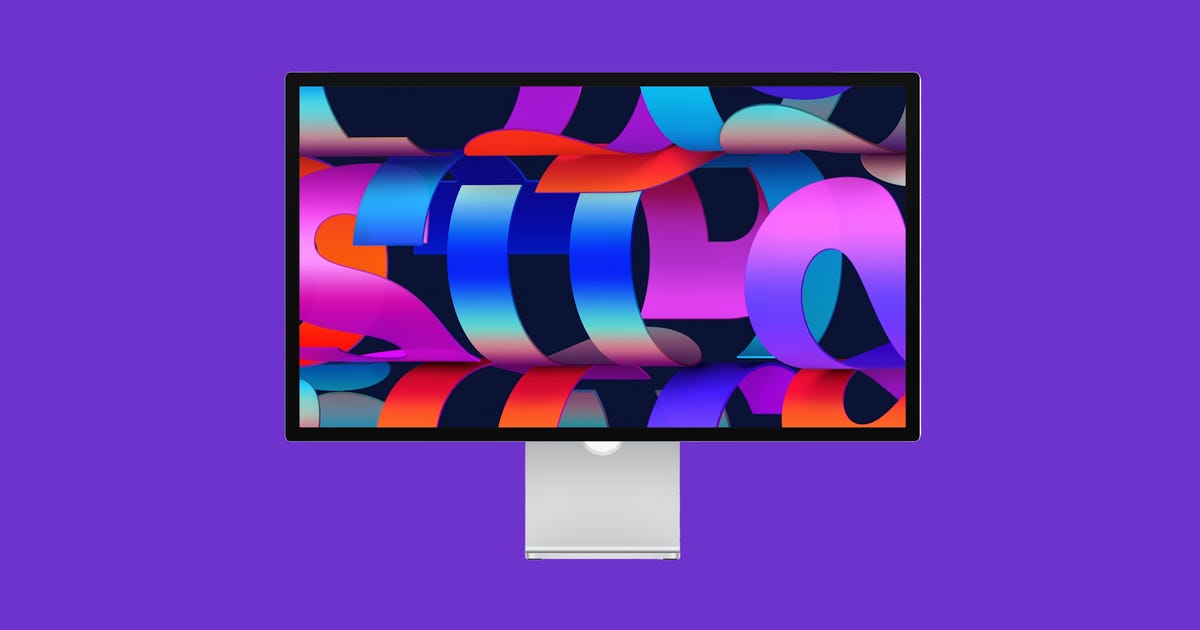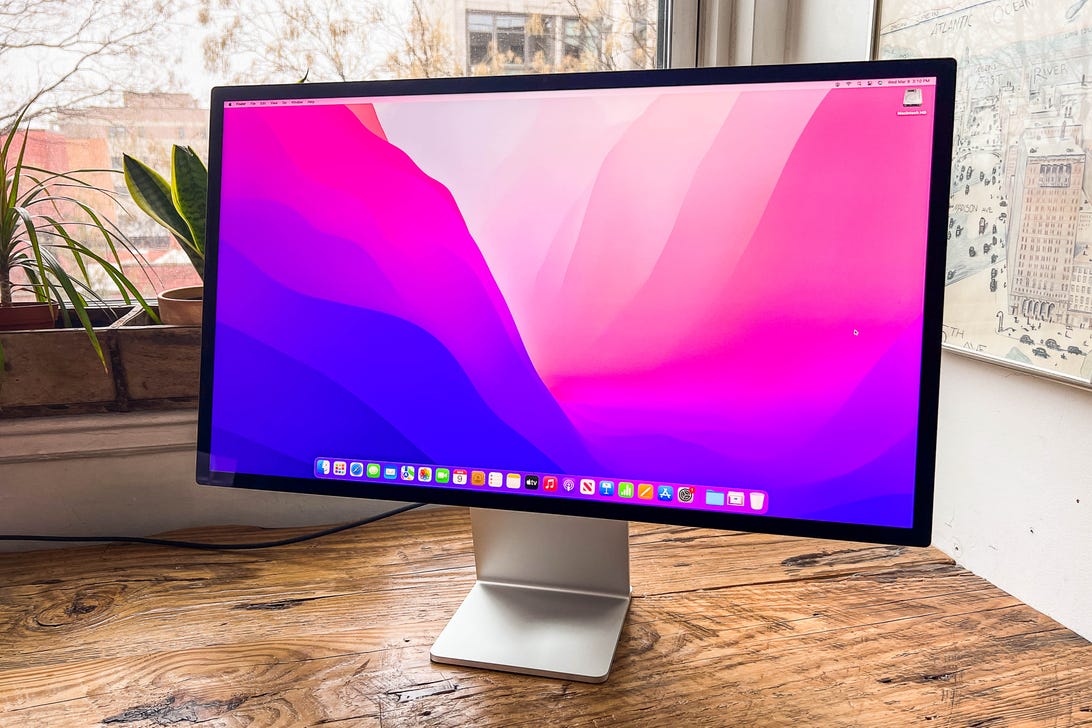

The show has very good coloration accuracy and unusually just right audio system for a track, making it a forged selection for Mac homeowners.
Dan Ackerman/CNET
When Apple introduced its $1,599 sibling to the $4,999 Professional Show XDR, I used to be amongst the ones disillusioned that the long-anticipated fashion wasn’t merely a smaller, lower-brightness model of its giant brother. No longer that the 27-inch Apple Studio Show is disappointing: It has got very good coloration accuracy and unusually just right audio system for a track, making it a forged selection for Mac homeowners. It is dear however now not overpriced for what it delivers; it merely provides each an excessive amount of and too little for its value.
Despite the fact that you settle for its standard form-over-function Apple-ness — no bodily controls, no simply out there ports, having to pay further for a height-adjustable stand and so forth — it is in the end dear for both section of people it is suited for. It will had been both a mainstream track smartly beneath $1,000 with a webcam and speaker machine, designed to hook up with a Mac Mini or MacBook Air, or a color-accurate track (with out the webcam and audio system) for the Mac Studio and MacBook Professional at nearer to $1,200. Seeking to be each on the identical time provides price.
Like
- Very good coloration accuracy and Apple-standard coloration profiles
- Excellent speaker machine for a track
Do not Like
- No bodily controls
- No HDR
- Meh Home windows compatiblity
- Peak adjustable stand is further price and neither selection lets in swiveling or rotation
- Just a unmarried enter connection
- No easy-access ports
And if the webcam is meant for creators, then it must be significantly better and feature device controls slightly than only a respectable high-resolution FaceTime digital camera with Middle Level, Apple’s device for routinely zooming and panning across the symbol. I do suppose lots of the problems with the webcam, just like the loss of a narrow-angle view for conferencing, relatively unimpressive noise relief and loss of world environment choices, will also be remedied with device updates. The mic’s audio high quality used to be positive, so long as you do not thoughts the loss of ambient noise relief.
Learn extra: Apple Mac Studio assessment
The audio system sound very good — for a track — however there may be some distortion whilst you crank them, and I overlooked the fullness a subwoofer would offer and the power to regulate extra than simply the quantity.
Apple Studio Show
| Value | Begins at $1,599. Nano-texture glass, $299; Tilt-and height-adjustable stand, $399; VESA mount adapter, no further price however no stand |
|---|---|
| Measurement (diagonal) | 27.0 in (69cm) |
| Panel and backlight | IPS with white LED |
| Flat or curved | Flat |
| Answer and pixel density | 5,120 x 2,880, 218 ppi |
| Facet ratio | 16:9 |
| Most gamut | 100% P3 |
| Brightness (nits, height/standard) | n/a/600 |
| HDR | None |
| Reference modes | sRGB, P3-D50 (Apple’s choice to Adobe RGB for print), P3-600 (Apple Show, local), DCI-P3 (6300K, gamma 2.6), Show P3 (6500K, gamma 2.2), HD/BT.709, PAL/SECAM, NTSC |
| Adaptive sync | None |
| Max vertical refresh price | 60Hz |
| Grey/grey reaction time (milliseconds) | n/a |
| Connections | 4 x USB-C (1 x Thunderbolt 3) |
| Audio | Six audio system |
| VESA mountable | Sure, 100 x 100 mm |
| Panel guaranty | 1 12 months restricted with 90 days loose tech make stronger |
| Unencumber date | March 2022 |
Unsurprisingly, the track does not play smartly with Home windows. No longer simply for the reason that webcam turns dumb within the absence of MacOS, however the loss of an onscreen show for switching reference coloration profiles blended with Home windows’ how-is-it-still-so-bad color-management interface makes coloration dealing with an excessive amount of hassle.
There also are some notable features lacking that may attraction to everybody. It tops out at a 60Hz refresh price, even though different Apple merchandise, just like the iPad Professional and a few MacBook Professional fashions, have ProMotion, Apple’s 120Hz variable refresh price era for smoother video playback and gameplay. Just like the XDR, the Studio Show’s controls are all in device, so, for example, if you wish to disable it or flip it off it’s a must to unplug it, and it is principally unusable with anything else as opposed to a Mac, until you wish to have a show and not using a controls.
And HDR, HDR, my kingdom for HDR. Despite the fact that it is only for playback and now not introduction.
There is a unmarried Thunderbolt 3 connection to glue the show and 3 USB-C connectors, regardless that they are all at the again the place they may be able to be anxious to get to, particularly in case you are continuously plugging and unplugging gadgets.
And if you are going to purchase this, spring for the height-adjustable stand. I needed to elevate my table to get it to the best stage. Our unit did not have the matte Nano Texture display screen, however the shiny is not too reflective so long as you do not have gentle streaming from at the back of.
However what in regards to the display screen?
The real show is very good, regardless that now not blow-your-socks-off remarkable. That is as a result of it is a conventional IPS panel with an ordinary white LED backlight, albeit one with out not unusual artifacts like backlight or edgelight bleeding.
It is rated for as much as 600 nits with its default Apple P3-600 profile and hit about 590 in trying out, however the black is just a little brighter than every other 600-nit screens I have noticed, too — about 0.27 nits. And prefer many IPS panels, coloration and gamma are rather less constant within the deep shadows than the remainder of the variety, regardless that it does not range so much. Distinction is set 1100:1, which is beautiful just right for an IPS panel. After all, sitting subsequent to the Professional Show XDR you’ll see the most obvious distinction from the XDR’s only-OLED-is-better black stage and its advanced element visibility within the darkest shadow spaces.
The color profiles work as they should, meaning they have brightness, white point and gamut boundaries locked to the values of the reference standards. In other words, for example, if you want to work in sRGB you’re restricted to 78 nits brightness. You can always create custom profiles, but those aren’t saved to the monitor.
It has all the same reference profiles as the XDR, except for the HDR-related ones. All the white points for the reference profiles measured within 100K of their targets (in other words, 6400K to 6600K for a 6500K profile) and hit their respective gamma curves — not quite as tightly in the shadows, as mentioned above. Same goes for brightness targets.
All the color gamuts for the reference profiles covered at least 98%. It uses a P3-D50 profile which Apple uses for “print and design” instead of Adobe RGB, but it doesn’t quite match; it covers only about 91% of Adobe RGB, and because P3 is shifted from Adobe RGB it doesn’t fare quite as well in some of the print-centric colors. It should only be an issue if you work with colors on the green-cyan edge of the Adobe RGB boundary, and you’ll have to rely on your design software to identify what colors will get clipped on the other side, where P3 extends beyond.
If you don’t have to worry about print, don’t care about HDR and need something with significantly better-than-average color accuracy, the Studio Display is a great Mac-only alternative to the substantially more expensive Pro XDR. But in its price range and below, the Studio Display has a lot more competition for people who want even a slightly different set of capabilities, so it’s not a complete slam dunk.
How we test monitors
For Windows systems, all measurements are performed using Portrait Display’s Calman 2021 software using a Calibrite ColorChecker Display Plus (formerly X-Rite i1Display Pro Plus) colorimeter and a Murideo Six-G signal generator for HDR testing. How extensive our testing is depends on the capabilities of the monitor, the screen and backlight technology used, and the judgment of the reviewer.
On the most basic models we may stick with just brightness, contrast and color gamut, while on more capable displays we may run tests of most user-selectable modes for gaming or color-critical usage, uniformity and so on. For the color work, we may also run tests to verify how white point accuracy varies with brightness.
Color accuracy results reported in units of Delta E 2000 are based on Calman’s standard Pantone patch set, plus the grayscale and skin tone patches. White points results are based on both the actual white value plus the correlated color temperature for the entire gray scale (21 patches, 0 to 100%) rounded down to the nearest 50K as long as there are no big variations. We also use Blur Busters‘ motion tests to judge motion artifacts (such as ghosting) or refresh rate-related problems that can affect gaming.
For Mac-dependent monitors, we use the same colorimeter but do our testing with DisplayCAL, terrific free color-management software based on the open-source ArgyllCMS engine. We perform similar measurements to the Windows systems where possible.

